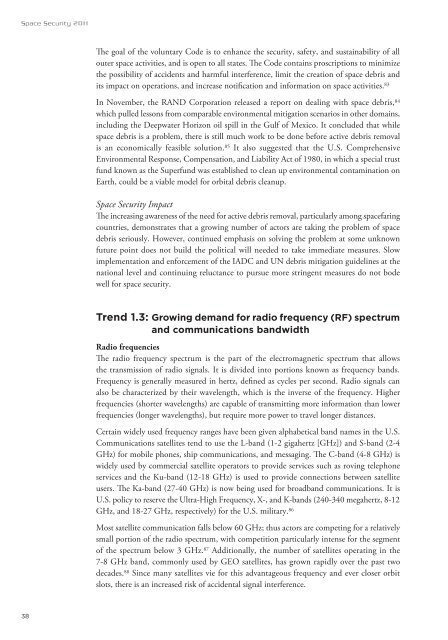Space Security Index
Space Security Index
Space Security Index
You also want an ePaper? Increase the reach of your titles
YUMPU automatically turns print PDFs into web optimized ePapers that Google loves.
<strong>Space</strong> <strong>Security</strong> 2011<br />
38<br />
e goal of the voluntary Code is to enhance the security, safety, and sustainability of all<br />
outer space activities, and is open to all states. e Code contains proscriptions to minimize<br />
the possibility of accidents and harmful interference, limit the creation of space debris and<br />
its impact on operations, and increase notication and information on space activities. 83<br />
In November, the RAND Corporation released a report on dealing with space debris, 84<br />
which pulled lessons from comparable environmental mitigation scenarios in other domains,<br />
including the Deepwater Horizon oil spill in the Gulf of Mexico. It concluded that while<br />
space debris is a problem, there is still much work to be done before active debris removal<br />
is an economically feasible solution. 85 It also suggested that the U.S. Comprehensive<br />
Environmental Response, Compensation, and Liability Act of 1980, in which a special trust<br />
fund known as the Superfund was established to clean up environmental contamination on<br />
Earth, could be a viable model for orbital debris cleanup.<br />
<strong>Space</strong> <strong>Security</strong> Impact<br />
e increasing awareness of the need for active debris removal, particularly among spacefaring<br />
countries, demonstrates that a growing number of actors are taking the problem of space<br />
debris seriously. However, continued emphasis on solving the problem at some unknown<br />
future point does not build the political will needed to take immediate measures. Slow<br />
implementation and enforcement of the IADC and UN debris mitigation guidelines at the<br />
national level and continuing reluctance to pursue more stringent measures do not bode<br />
well for space security.<br />
Trend 1.3: Growing demand for radio frequency (RF) spectrum<br />
and communications bandwidth<br />
Radio frequencies<br />
e radio frequency spectrum is the part of the electromagnetic spectrum that allows<br />
the transmission of radio signals. It is divided into portions known as frequency bands.<br />
Frequency is generally measured in hertz, dened as cycles per second. Radio signals can<br />
also be characterized by their wavelength, which is the inverse of the frequency. Higher<br />
frequencies (shorter wavelengths) are capable of transmitting more information than lower<br />
frequencies (longer wavelengths), but require more power to travel longer distances.<br />
Certain widely used frequency ranges have been given alphabetical band names in the U.S.<br />
Communications satellites tend to use the L-band (1-2 gigahertz [GHz]) and S-band (2-4<br />
GHz) for mobile phones, ship communications, and messaging. e C-band (4-8 GHz) is<br />
widely used by commercial satellite operators to provide services such as roving telephone<br />
services and the Ku-band (12-18 GHz) is used to provide connections between satellite<br />
users. e Ka-band (27-40 GHz) is now being used for broadband communications. It is<br />
U.S. policy to reserve the Ultra-High Frequency, X-, and K-bands (240-340 megahertz, 8-12<br />
GHz, and 18-27 GHz, respectively) for the U.S. military. 86<br />
Most satellite communication falls below 60 GHz; thus actors are competing for a relatively<br />
small portion of the radio spectrum, with competition particularly intense for the segment<br />
of the spectrum below 3 GHz. 87 Additionally, the number of satellites operating in the<br />
7-8 GHz band, commonly used by GEO satellites, has grown rapidly over the past two<br />
decades. 88 Since many satellites vie for this advantageous frequency and ever closer orbit<br />
slots, there is an increased risk of accidental signal interference.

















